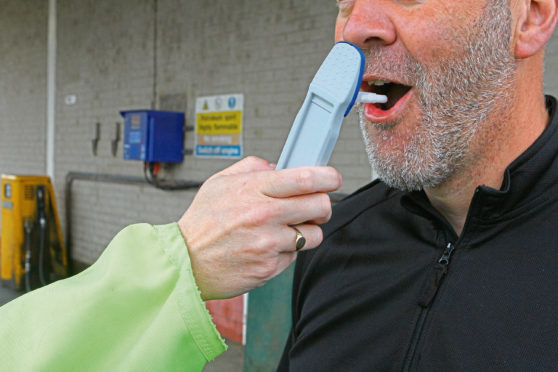Police officers in Dundee will soon be able to instantly test drivers for cannabis and cocaine with a roadside saliva test.
The kit can determine within minutes if the driver has drugs in their system, allowing officers to move straight for a blood test.
This blood sample will then be sent for analysis to detect 17 different controlled drugs with set limits under new drug driving legislation.
If it comes back positive then the driver will be charged with drug driving, under section 5(a) of the Road Traffic Act 1988.
PC Aileen Walker, of road policing management support at Police Scotland, said: “At least 80% of all drug users ingest a combination of drugs and most of them use cannabis or cocaine.
“These roadside tests give us the power to immediately instruct a medical professional to take a blood sample, instead of waiting for the driver to be assessed by a doctor first, as is current practice.
“It can sometimes take several hours for a doctor to attend and then a sample to be taken, meaning that someone who is just over the limit can drop below the limit during the delay.
“This equipment speeds up the whole process and reduces the chances of that happening.”
Section 5(a) states that it is an offence to be driving under the influence of 17 specified drugs and gives a legal limit – as section 5(1)(a) does for drink driving.
It is currently in force in England and Wales, and Scotland will follow suit on October 21. Officers will be given training from August onwards about the drug driving legislation and specialist officers will be trained to use roadside drug testing kits.
Two different devices will be piloted across the country before the equipment is purchased, the first of which is an instant test.
This test is run over the tongue of the driver and displays a result on a small panel – similar to a pregnancy test. The second device takes a swab from the driver’s mouth, which is then inserted into a testing machine.
PC Keith Sutherland said: “One or the other of the tests will be in all police cars after the legislation is introduced and all trained officers on patrol will have access to them.
“If we detect any indication the driver might be under the influence of drugs we can use these tests and if the driver refuses to comply then that is an offence in itself.”
The subsequent blood sample is tested for 17 illegal and prescription drugs which affect a motorist’s judgment and ability to drive.
These drugs include heroin, speed, cocaine, cannabis, Valium, ketamine, LSD, meth, MDMA and benzoylecgonine – which is what your body breaks cocaine down into.
Also on the list are prescription drugs methadone, morphine and temazepam, and four different benzodiazepines – clonazepam, flunitrazepam, lorazepam and oxazepam.
>> Keep up to date with the latest news with Evening Telegraph newsletter
Each drug detected is a separate offence and leads to its own individual charge, which is presented to the procurator fiscal for prosecuting.
If none of these drugs are detected, then the driver can still be charged under section 4, which states it is an offence to be driving under the influence of drink or drugs.
PC Walker added: “This is another tool to help reduce the amount of drug drivers on our roads.”
A Scottish Government spokeswoman said: “The introduction of drug driving limits will strengthen the power of Scotland’s police and prosecutors to tackle the minority of drivers who irresponsibly put themselves and other road-users at risk.
“Once implemented, this new legislation will ensure Scotland has the UK’s most robust laws against impaired and unsafe driving.”
